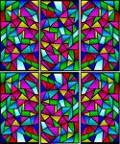
 |
 |
 |
 |
Stained Glass Reviews
Stained Glass Painting
Stained Glass Painting
There are many techniques that can be used to create beautiful and interesting works of art in stained glass. This article deals with stained glass painting. This technique has been used for centuries and was the most obvious form of stained glass during the Renaissance era due to their keen aspiration for intricate details in artwork. Painting of stained glass became so popular, in fact, that the earlier stained glass arts of using " pot metal glass " almost disappeared in toto.
You will need several items helpful to do stained glass painting. Obviously you will need paint and paintbrushes, if you cannot ready the specialized stained glass type you may be able to improvise with regular artist's paintbrushes. You will also need access to a kiln to set your effort. Many professional studios will allow you to use their kiln for an hourly rate. Next, you will must a palette for mixing your paint. A piece of sandblasted glass is the immeasurably suitable choice for mixing you stained glass paints. A palette knife is a helpful tool in mixing the paint. The paints are made from a mixture of powdered oxides, gum arabic and water.
As with other forms of stained glass art, you will want to start with your originate on paper. Make sure there is some definition to your design and that the differently colored areas are outlined in a darker color. You may tape your design to the bottom of your glass so that it will remain in place during painting. Begin painting the dark outlines of your design with a tracer or rigger ( long brush with a slender point ). You will want your trace paint to be dark enough to block out light and provide discrepancy with your lighter colors. You must apply the outlines in long, smooth, continuous strokes. Do not try to " go over " your lines once they have dried ( which does not take prolonged! ).
If you do you will create the paint to bubble and separate ( fry ) when the glass is fired in the kiln. You should not touch the line at all once it has been painted, although you may fitting some mistakes and overages by gently scraping the paint off with a toothpick AFTER it has dried completely. Next, your stained glass trace colouring is fired in the kiln at approximately 1150? F.
After your trace paint has been fired, you are ready to apply your shading colors. The shading color may be dropped into a particular area of the stained glass and then brushed or " mopped " over the entire venue where that color is desired. You may then purpose various brushes with different strokes or techniques to create a stippled or otherwise textured look. Garner in mind that the color of the shaded area will appear lighter in your finished stained glass project after it has been fired in the kiln.
You may also wish to enhance the look of your project with pennies stain. Silver stain will be applied to the back side of your stained glass project ( the opposite side from your painting ) and will actually change the color of the glass rather than simply cover it. Change stain can be corrosive as it contains silver nitrate since use with caution and please use clean brushes for this portion of the project. The effect of silver stain is a lovely yellow to amber - colored hue to the stained glass and provides a lovely background to your stained glass artwork.
Your skill and technique in painting stained glass will improve over time, as with any new endeavor. Be discerning and allow yourself to enjoy the process. Painting stained glass can be a superb hobby and with a little inwardness you may even create a masterpiece someday!
 |
 |
 |
Stained Glass Lead Came Technique
Turn Your Stained Glass Hobby Into A Fun Job
Stained Glass Windows A Light Unto The Soul
Stained Glass Projects For Children
Stained Glass Scoring And Breaking An Art In Itself
Stained Glass Workshop Safety Tips
Designing Your Own Stained Glass
Accountancy
Acupuncture
Adoption
Affiliate Marketing
Alternative Energy
Alzheimers
American History
Anger Management
Aquarium
ATV
Autograph Collecting
Bachelorette Parties
Bargain Hunting
Bathroom Accessories
Beauty
Belgian Chocolate
Bipolar
Black History
Blog Marketing
Bodybuilding Supplements
Body Detox
Body Jewelry
Building Self Esteem
Business
Career Hunting
Caring For The Elderly
Choosing The Right
Golf Clubs
Christmas Shopping
More Stained Glass Reviews
Stained Glass Workshop Safety Tips
... that your area is well ventilated when you are soldering. Fumes from solder and flux contain harmful lead and acid. Solder scraps should be kept in a special container for taking to a recycler. Sometimes new stained glass crafters don't have a workshop and think they can begin by going at their kitchen ...
John La Farge, American Stained Glass Artist
... March 31, 1835 to french immigrant parents. Upon eventuality of his formal education in law he ventured to Europe to study art. After his share to the United States he made a brief attempt at practicing law, but soon gave it up to follow his passion for prolific expression. Initially, he painted landscapes ...
Stained Glass Projects For Children
... thicker and the colors were rich and dark. Throughout the decades styles and tastes changed and new ways of using stained glass were needed. As people wanted to get more detail in their stained glass windows and also allow more light in, they began to use the technique of painting on the glass, rather ...
... has coloring agents like sand, alumina, clay, red or white lead oxide, boric sharp, potassium and sodium. The lead in the stained glass tint refracts light. The matt ( paint ) can be applied, taken out in the tracing, fired, and then applied again, depending on the lighting, detail, and textures you yearning ...

|
| Copyright © 2006-2012 Internet Marketing Tools, All Rights Reserved |